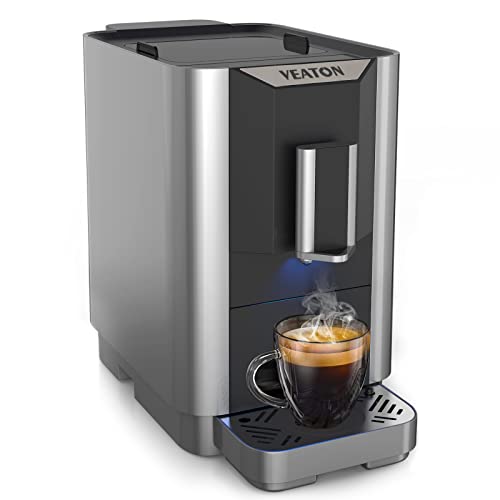How to Use a Coffee and Espresso Maker
A coffee and espresso maker makes shots of pressurized water that is forced through finely ground, tightly packed espresso beans. The result is a drink that is extremely flavorful with a thick layer of crema on top.
Certain machines let you determine the strength of your drink through pods or ground coffee, while others steam milk to make cappuccinos or lattes. There's a stovetop model that operates like a Moka pot.

1. Buying Guide
The most effective espresso maker and coffee maker is not just a machine for pouring hot water over the grounds. machines espresso machines 's also an appliance that can help you create cafe-quality drinks in your home. There are a lot of options in this category and it can get overwhelming. However there are certain aspects to consider when choosing the best machine.
Understanding the various brewing methods is the first step. Certain machines rely on gravity to filter water through grounds while others brew using a pump. These differences can affect the final flavor and cost.
The most advanced espresso and coffee makers are usually the most expensive. They may come with digital controls or programmable settings. It's important to consider the frequency of use for your espresso maker and coffee maker, and whether the additional costs are worth it.
Semiautomatic models are available at a lower price and provide an alternative between manual and automated operation. These machines require manual work, such as grinding and tamping. However they are more affordable than fully automated models and offer an easier and more controlled brewing process.
2. Instructions
Utilizing a coffee or espresso maker is easy. The most important thing is to select the appropriate ingredients and then set up the machine. It is recommended to use freshly ground coffee beans, which are ground using a burr mill designed for espresso. The grinder creates an extremely fine, uniformed powder that releases the finest flavors from the bean. You can also make use of a steam wand blend milk into lattes or cappuccinos.
You will need to switch on the espresso machine and let it heat up before making any drinks. It can take a few minutes, based on the machine's size. It is crucial to ensure that the machine is heated evenly. The process can be speeded up by pulling a blank which will run the machine with no grounds in the portafilter. This will not only heat your cup, but also flushes out the group head to prevent the buildup of water that is dirty.
Once your machine is heated, you can add the ground coffee into the portafilter. Then, tamp down on the grounds to ensure that they are evenly and tightly packed. You can buy the tamper from Amazon or at the majority of espresso stores. After you have finished, you can turn on the espresso machine and place one small cup under each spout. Turn the control panel on the espresso position to brew espresso. This activates micro-switches which start the heating chamber and pump and push the hot water through the ground and out of spouts.
3. Ingredients
A coffee or espresso machine can create a wide variety of drinks. In fact, they are among the most versatile brewing equipment. They can be used to create espresso and drip drinks.
Espresso is an intense coffee drink that is produced by forcing hot high-pressure water through finely ground beans in a very short amount of time. Espresso is typically sweeter and thicker than regular coffee. It's an excellent way for you to experience more complex flavors than those in drip coffee. However, it's not ideal for everyone.
The best espresso is dark-roasted and coarsely ground to maximize flavor extraction. Vigil suggests that you "bloom" your coffee prior to making your coffee, which is to pour hot water over the grounds and waiting for 20-30 minutes (releases the flavor notes). After adding the remaining hot water, use the machine's pressure to push the water into the coffee grounds.
Certain machines are more efficient than others. This is why some coffee and espresso makers have a bad reputation for being difficult to use. But with a bit of practice, you'll make your own espresso at cafe quality in no time.
There are some other ways to make almost-espresso without the use of a machine, for instance with a siphon (a fancy glass device that makes use of pressure from vapors to immerse grounds in hot water). This is a time-consuming and time-consuming process.
4. Preparation
Before using your espresso maker, ensure your machine is connected and is preheated. It is essential to maintain the same temperature throughout the brewing process so that you get the maximum amount of flavor. It's a good idea to "bloom" or pour a little hot water onto the coffee grounds for 30 seconds. This will help to release carbon dioxide from the beans and improve the taste of your espresso.
When the brew process is complete, remove the portafilter and serve. You can make espresso using an espresso maker, to brew single and double shots, or a steam wand or milk frother to create popular cafe drinks like lattes and cappuccinos. Add a little sugar to your espresso shot for a sweeter, more luxurious drink.
You can also use your espresso maker to make the coffee you want, but you will need to use a filter as most models do not have the capacity to pour a full pot. To make a great pot of coffee, you'll have to start with freshly ground beans that have already been ground to a proper consistency.
You can also experiment by using different types of water. Hard water has more insoluble minerals, which can cause mineral buildup and less flavorful drinks. Soft or filtrated water can cut down on the buildup.
